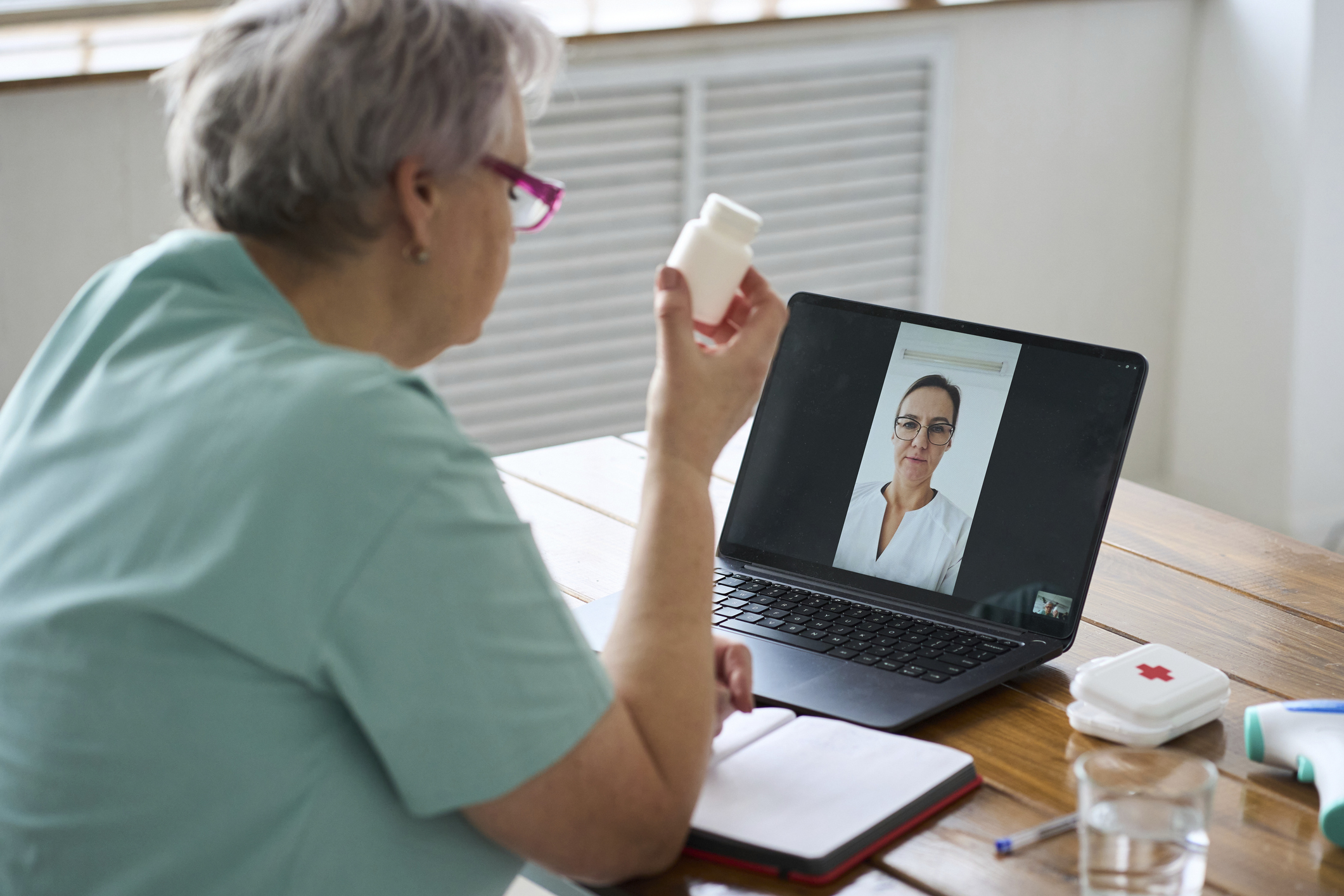Expanded Medicare Telehealth Services Available for an Additional Six Months
All Medicare beneficiaries still have access to telehealth services until September 30. Starting October 1, you must be located in a rural area for most telehealth services.


All Medicare beneficiaries will continue to have access to most telehealth services until September 30, 2025. The pandemic era program set to shrink on March 31 was extended in the Full-Year Continuing Appropriations and Extensions Act (H.R.1968), signed into law on March 15, 2025. This was the second reprieve for the program. It was previously extended in The American Relief Act (H.R. 10545) passed to fund the government and avoid another shutdown.
So, whether you are worried about picking up a cold in your doctor's waiting room or plan on traveling as soon as the weather turns warmer , you can still use the telehealth option to take care of many of your health needs.
Medicare patients in both urban and rural areas can use telehealth services at any location in the U.S., including your home, until September 30. Beginning October 1, you must be in an office or medical facility located in a rural area (in the U.S.) for most telehealth services. However, if you aren't in a rural health care setting, there are a limited number of telehealth services you will remain eligible to get on or after October 1.
From just $107.88 $24.99 for Kiplinger Personal Finance
Become a smarter, better informed investor. Subscribe from just $107.88 $24.99, plus get up to 4 Special Issues

Sign up for Kiplinger’s Free Newsletters
Profit and prosper with the best of expert advice on investing, taxes, retirement, personal finance and more - straight to your e-mail.
Profit and prosper with the best of expert advice - straight to your e-mail.
Telehealth costs and what is covered
While use of telehealth services has declined since the onset of COVID-19, it remains nearly two times higher than pre-pandemic levels, with more than one in ten (12.7%) eligible beneficiaries receiving a telehealth service in the last three months of 2023, according to KKF. The pandemic-era flexibilities included in Medicare telehealth coverage that were due to expire on December 31, 2024 were extended for three months by The American Relief Act.
Medicare Part B (medical insurance) covers certain telehealth services and you'll pay the same amount that you would if you received the services in person. You're responsible to pay 20% of the Medicare-approved amount for your doctor or other health care provider/practitioner’s services and the Part B deductible applies. Basically, for most of these services, you’ll pay the same amount for telehealth services as you do for in-person visits.
With telehealth, you can't receive care that includes procedures that require a physical examination, taking blood or urine samples, performing X-rays or giving injections.
Medicare currently offers coverage for preventive health screenings, office visits, and psychotherapy. The menu of covered services was expanded in 2020 to include: physical and occupational therapy, emergency department visits and nursing facility care.
Telehealth can be used to take care of your health in a number of ways:
- Behavioral health services. Services offered include mental health screenings, addiction counseling, to monitor and manage symptoms of anxiety and depression and dispensing medication.
- Test results. Checking results from lab tests or x-rays
- Follow-up care. Checking in with your provider after surgery and managing your medicines
- Non-emergency urgent care. Getting help for common ailments such as colds or an upset stomach and checking on common problems like headaches or infections
- Therapeutic treatments. Physical or occupational therapy sessions
- Remote monitoring. You can use technology to track and share health data with your health provider. This is called remote patient monitoring or RPM. Some RPM tools track blood sugar levels, heart rates, blood pressure and weight.
Medicare Advantage. Medicare Advantage (MA) plans are required to cover all Part A and Part B benefits covered under traditional Medicare, and have some flexibility to offer additional telehealth benefits similar to their coverage of eye exams and dental check-ups. MA plans may continue to offer the expanded services after March 31 regardless of the status of the temporary telehealth expansions in traditional Medicare.
While telehealth won't save you anything financially, it may save you some time and inconvenience.
The benefits of telehealth
Having a telehealth visit is just like a regular visit, but you are in one place and your health care provider is in another. Although you may need to see your doctor in person for most diagnostic tests or any diagnosis that relies on a hands-on physical assessment, telehealth has many potential benefits. As with most things health related, talk to your health care provider to see if telehealth is a good fit for you and the conditions you might seek to treat or manage through telehealth.
Some of the benefits that Medicare beneficiaries could enjoy include:
- For the immunocompromised: Doctors’ offices and waiting rooms can fill up with contagious people. A telehealth visit can keep you and others in your home from getting sick from being in proximity to those sick with a cold, the flu or pneumonia
- Convenience: Snowbirds, those impacted by disasters or winter weather can be seen by a medical professional regardless of current location. You can see your doctor anywhere: home, work, or your temporary/seasonal home
- Appointment speed and expanded selection of caregivers: You may get an appointment faster and will have more choices. You can have a visit with a health care provider who has the skills you need and may be far from you
- Saves time: It saves time because you don’t need to travel, take time off from work or find a substitute caregiver in your absence
Telehealth services that will continue for all Medicare patients as of April 1 and after
You’ll still be able to get certain telehealth services without being in a rural area. While some non-mental health services may be available via telehealth depending on specific circumstances, most other telehealth services have geographic and/or originating site restrictions.
Below is a non-exhaustive list of services anyone can receive without being in a rural area. They include:
- Monthly End-Stage Renal Disease (ESRD) visits for home dialysis
- Services for diagnosis, evaluation, or treatment of symptoms of an acute stroke wherever you are, including in a mobile stroke unit
- Behavioral health services, also called mental health services, for the diagnosis, evaluation, or treatment of a mental health disorder, including in your home. Services to treat a substance use disorder or a co-occurring mental health disorder including in your home
- Diabetes self-management training
- Medical nutrition therapy
Bottom line
Prior to the pandemic-era expansion to Medicare to include patient's homes as a permissible “originating site," telehealth coverage was limited to rural areas (with certain exceptions), and patients were required to travel to an approved originating sites, such as a clinic or doctor’s office, when receiving telehealth services.
Currently one workaround for those enrolled in traditional Medicare is using a provider that participates in an Accountable Care Organization (ACO). An ACO is a group of doctors, hospitals, and other health care providers who work together to coordinate your health care. They are permitted to waive these requirements and may continue to provide telehealth services without geographic restrictions, and to beneficiaries in their homes, should the current flexibilities expire.
Overcoming the geographic and originating site requirements for Medicare patients to receive services is essential to a meaningful expansion of telehealth services. Unfortunately proposed legislation, such as the Telehealth Modernization Act of 2024, doesn't include a repeal and only offers a temporary extension of the waiver of the requirements.
Related Content
Profit and prosper with the best of Kiplinger's advice on investing, taxes, retirement, personal finance and much more. Delivered daily. Enter your email in the box and click Sign Me Up.

Donna joined Kiplinger as a personal finance writer in 2023. She spent more than a decade as the contributing editor of J.K.Lasser's Your Income Tax Guide and edited state specific legal treatises at ALM Media. She has shared her expertise as a guest on Bloomberg, CNN, Fox, NPR, CNBC and many other media outlets around the nation. She is a graduate of Brooklyn Law School and the University at Buffalo.
-
 December Fed Meeting: Live Updates and Commentary
December Fed Meeting: Live Updates and CommentaryThe December Fed meeting is one of the last key economic events of 2025, with Wall Street closely watching what Chair Powell & Co. will do about interest rates.
-
 This Is Why Investors Shouldn't Romanticize Bitcoin
This Is Why Investors Shouldn't Romanticize BitcoinInvestors should treat bitcoin as the high-risk asset it is. A look at the data indicates a small portfolio allocation for most investors would be the safest.
-
 I'm a Federal Benefits Pro: I Answer These 2 Questions a Lot
I'm a Federal Benefits Pro: I Answer These 2 Questions a LotMany federal employees ask about rolling a TSP into an IRA and parsing options for survivor benefits, both especially critical topics.
-
 I'm a Financial Pro Focused on Federal Benefits: These Are the 2 Questions I Answer a Lot
I'm a Financial Pro Focused on Federal Benefits: These Are the 2 Questions I Answer a LotMany federal employees ask about rolling a TSP into an IRA and parsing options for survivor benefits, both especially critical topics.
-
 Smart Money Moves Savers Should Make in 2026
Smart Money Moves Savers Should Make in 2026These steps will get you on the road to achieving your 2026 savings goals.
-
 I Retired at 63 to Enjoy My Free Time but My Grown Kids Want Help With Childcare. I Love My Grandkids but It's Too Much. What Should I Do?
I Retired at 63 to Enjoy My Free Time but My Grown Kids Want Help With Childcare. I Love My Grandkids but It's Too Much. What Should I Do?We asked therapists and relationship experts for advice.
-
 5 RMD Mistakes That Could Cost You Big-Time: Even Seasoned Retirees Slip Up
5 RMD Mistakes That Could Cost You Big-Time: Even Seasoned Retirees Slip UpThe five biggest RMD mistakes retirees make show that tax-smart retirement planning should start well before you hit the age your first RMD is due.
-
 I'm a Wealth Adviser: My 4 Guiding Principles Could Help You Plan for Retirement Whether You Have $10,000 or $10 Million
I'm a Wealth Adviser: My 4 Guiding Principles Could Help You Plan for Retirement Whether You Have $10,000 or $10 MillionRegardless of your net worth, you deserve a detailed retirement plan backed by a solid understanding of your finances.
-
 A Retirement Triple Play: These 3 Tax Breaks Could Lower Your 2026 Bill
A Retirement Triple Play: These 3 Tax Breaks Could Lower Your 2026 BillGood news for older taxpayers: Standard deductions are higher, there's a temporary 'bonus deduction' for older folks, and income thresholds have been raised.
-
 10 New Year's Resolutions for Retiring Next Year
10 New Year's Resolutions for Retiring Next YearThese New Year's resolutions will help you retire in 2026 with confidence in your financial strategy.
-
 How Much Would a $50,000 HELOC Cost Per Month?
How Much Would a $50,000 HELOC Cost Per Month?Thinking about tapping your home’s equity? Here’s what a $50,000 HELOC might cost you each month based on current rates.